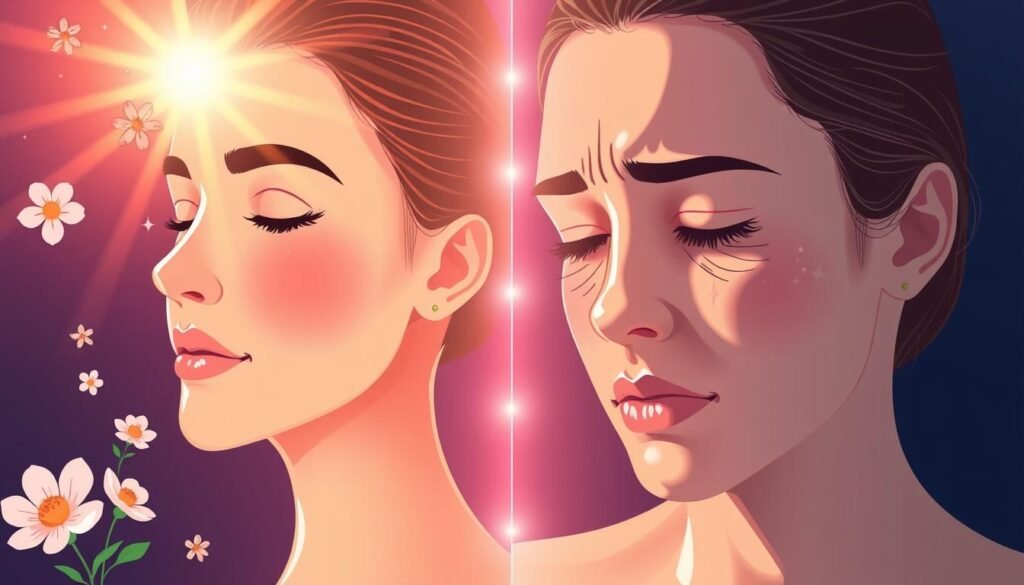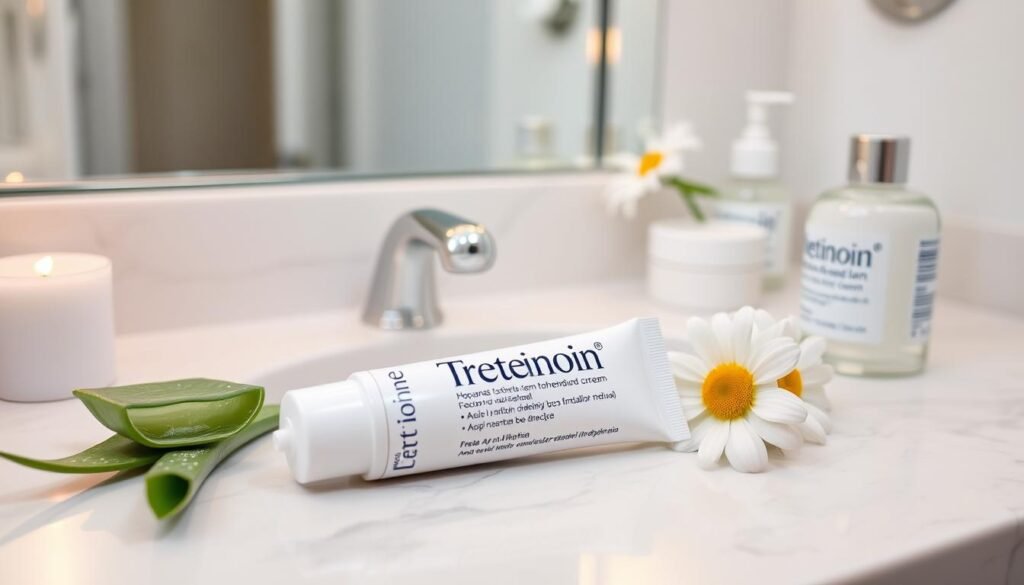Did you know Tretinoin cream has been battling acne for nearly 50 years? A 2017 review shows it works on both noninflammatory and inflammatory types. This cream speeds up skin cell turnover. It improves skin texture and tone while reducing fine lines and dark spots. We’ll look into Tretinoin cream’s pros and cons and how it fights acne. This info will help whether you’re just starting or want better results.
Key Takeaways
- Tretinoin has been effective in treating acne for almost 5 decades.
- Topical retinoids like Tretinoin work on both noninflammatory and inflammatory acne.
- Results may start appearing as early as 2 to 3 weeks but could take up to 12 weeks for full benefits.
- Common side effects include redness, dryness, and peeling, especially in the initial weeks.
- Consult a healthcare provider if no improvement is seen within 12 weeks of use.
- Caution is advised to prevent sun exposure due to increased sensitivity.
What is Tretinoin?
Tretinoin is a topical lotion, a type of medication called retinoids. It’s mainly used for acne and sun damage as a prescription-strength medication. Known chemically as retinoic acid, it’s a man-made form of vitamin A.
It works by speeding up skin cell turnover, helping remove old skin and reveal new, healthier skin. Tretinoin is more potent than over-the-counter vitamin A options and needs a doctor’s prescription. It’s safe for use by people as young as nine for certain conditions.
Most users might feel some irritation or dryness with tretinoin use, which is normal. Start with a low concentration to lessen these effects. A pea-size amount covers the face well, aiding in easy application.
Apply tretinoin at night and use sunscreen in the day to boost effectiveness and prevent sun harm. Side effects like allergies or mild irritation are uncommon. Keep it stored properly between 59-86 degrees Fahrenheit to maintain its effectiveness.
Slowly increasing the dose and how often you use it can help add tretinoin to your skin care safely. Its many uses go beyond just acne treatment, showing its wide range of benefits for the skin.
Understanding Tretinoin Cream Uses
Tretinoin cream is a strong fighter against acne. It doesn’t just tackle mild to moderate acne. It also works on improving skin health. The cream cuts down on oil, boosts skin renewal, and encourages collagen and elastin growth. So, people notice their skin looking and feeling better.
This cream starts to kick in around 2-3 weeks, showing full effects after six weeks. It becomes a key tool in reducing acne flare-ups. This makes it a trustworthy choice for those fighting off stubborn acne.

Besides tackling acne, Tretinoin cream helps with other skin issues. It’s great for lessening fine lines and lightening dark spots from the sun. Those looking for better skin health often use Tretinoin with other creams for improved outcomes.
| Benefit | Effectiveness Timeline |
|---|---|
| Acne reduction | 2-3 weeks |
| Skin texture improvement | 3-4 months |
| Sun damage repair | 3-6 months |
| Reduction of fine lines | 6 weeks or more |
Tretinoin is even more effective when teamed up with other products, like hyaluronic acid. But, stay away from vitamin C. This mix helps greatly improve the skin’s look and health.
Benefits And Side Effects of Using Tretinoin Cream
Tretinoin cream is great for your skin. It helps those with acne and sun damage. The cream makes cells renew faster, reducing acne and improving skin texture. People under 50 often use it at bedtime. They treat dark spots and wrinkles with it. For those over 50, a doctor will decide how much they should use.
Using the cream might cause skin irritation at first. About 30% feel irritation in the first three weeks. Acne can get worse before it gets better for some, happening to about 50% of users. Keeping up with your skincare routine is key to getting good results.

To lessen dryness and peeling, use a thin layer once a day. People nine and older should do this carefully. You must use sunscreen with at least SPF 15, as the cream makes skin sun-sensitive. Wearing protective clothes and using moisturizers helps with skin irritation.
Knowing the benefits and side effects of using tretinoin cream is important. Customizing your skincare to fit your needs can make a big difference. For tips on a good skincare routine, check out this resource.
How Tretinoin Works for Acne Treatment
Tretinoin is key in acne control. It speeds up skin cell turnover. This action helps avoid pore blockages, which cause acne breakouts. It deals with current acne and helps stop new ones.
Studies show tretinoin helps with both main types of acne. It keeps hair follicles clear, fighting acne. Research backs up its success in reducing acne spots over time.
It takes about 12 weeks to see changes with tretinoin cream. Early on, you might see skin redness and feel irritation. Yet, with regular use, the skin improves noticeably.

| Factor | Details |
|---|---|
| Application | Once daily at bedtime for optimal absorption |
| Initial Side Effects | Burning, itching, peeling, redness, and dryness |
| Time for Results | Up to 12 weeks to see noticeable improvement |
| Prescription Requirement | Required in the United States |
| Safety for Pregnant Individuals | Not recommended for use |
| Combination Therapies | Can be effective with benzoyl peroxide or clindamycin |
Topical retinoids like tretinoin are proven acne fighters. Reviewing over 54 studies confirms this. Starting with a low dose helps your skin adjust with fewer side effects. This way, you get the skin benefits without much discomfort.
Retinoid Benefits for Skin Health
Retinoids, like tretinoin, bring many benefits to skin health. Tretinoin is a top pick for better skin texture and reducing wrinkles and dark spots. It boosts collagen, making skin more elastic and firm.
People use topical retinoids for their strong anti-aging properties. These compounds are great for treating acne and fighting aging signs. A 2016 study showed that retinol and tretinoin increase collagen, helping to smooth fine lines and improve complexion.
Talking to a dermatologist helps find the right retinoid. Early benefits like clearer skin and a youthful glow can be seen in a few weeks. With regular use, skin becomes smoother and fine lines and dark spots fade away.
| Time Frame | Visible Improvements |
|---|---|
| 6 weeks | Initial results in skin clarity and texture |
| 8-12 weeks | Noticeable reduction in sun damage, smoother skin, and decreased pore size |
| >6 months | Significant skin tightening, reduced fine lines, and fading of hyperpigmentation |
Adding retinoids to your skincare can greatly improve skin health. Tretinoin’s lasting effects keep skin looking young. It brings both quick and enduring benefits for vibrant, healthy skin.
Understanding Tretinoin Side Effects
Tretinoin cream is a strong retinoid for treating skin conditions. It can cause certain Tretinoin side effects at the start. Users may see skin irritation, like redness, drying, and peeling. This usually happens in the first two to four weeks and is normal.
While mild symptoms are common and tend to go away, severe reactions need attention. If you see blistering or feel very sensitive, get help. Checking your skin’s reaction helps to make changes to your treatment if needed.
Adjusting your skincare routine helps as your body gets used to tretinoin. Stay away from tough skincare products and too much sun. Always use a broad-spectrum sunscreen for protection.
Knowing how to handle Tretinoin side effects makes the treatment work better. It leads to smoother skin and a brighter look with time. For help with these effects, talk to a doctor or check out reliable sources, like this guide.
Using Tretinoin: Before and After Care
Right Tretinoin before and after care boosts treatment results and reduces side effects. It’s key to follow a skincare routine that suits you to get the most from tretinoin.
Before putting it on, your skin must be clean and dry. This is important because it gets your skin ready for tretinoin. After you apply it, using a good moisturizer is crucial. It helps with the dryness tretinoin can cause, making your skin feel better and more moist.
Add some necessary skincare routine tips to improve your tretinoin experience. Cut down on using products that could irritate, like alcohol-based toners or scrubs. These can make skin irritation worse, making tretinoin less effective.
Don’t forget about protecting your skin from the sun. Tretinoin makes your skin more sensitive to sunlight. So, you must use sunscreen regularly. Choose one that covers all types of UV light. This helps keep your skin healthy.
To wrap it up, knowing how to take care of your skin properly with Tretinoin before and after care is critical. A well-thought-out skincare routine, including the right use of moisturizer and other products, helps you see the best results. It also makes the experience more comfortable for you.
How to Apply Tretinoin Cream Effectively
To get the best from tretinoin cream for acne, start right. First, wash and dry your face well. This reduces irritation risks. You should apply a pea-sized amount at night to the targeted areas. Doing this checks the cream’s dosage and how your skin reacts.
Be careful with other products when using tretinoin. Avoid mixing it with harsh items like benzoyl peroxide or lactic acid unless a dermatologist says it’s okay. To boost tretinoin’s effect, use a good moisturizer and sunscreen with SPF 50. This protects your skin from irritation by the sun.
Sticking with it is crucial. Using it daily can make a big difference, lowering acne. Following these steps helps you handle side effects like dryness and peeling. You’ll end up with clearer skin by being consistent.